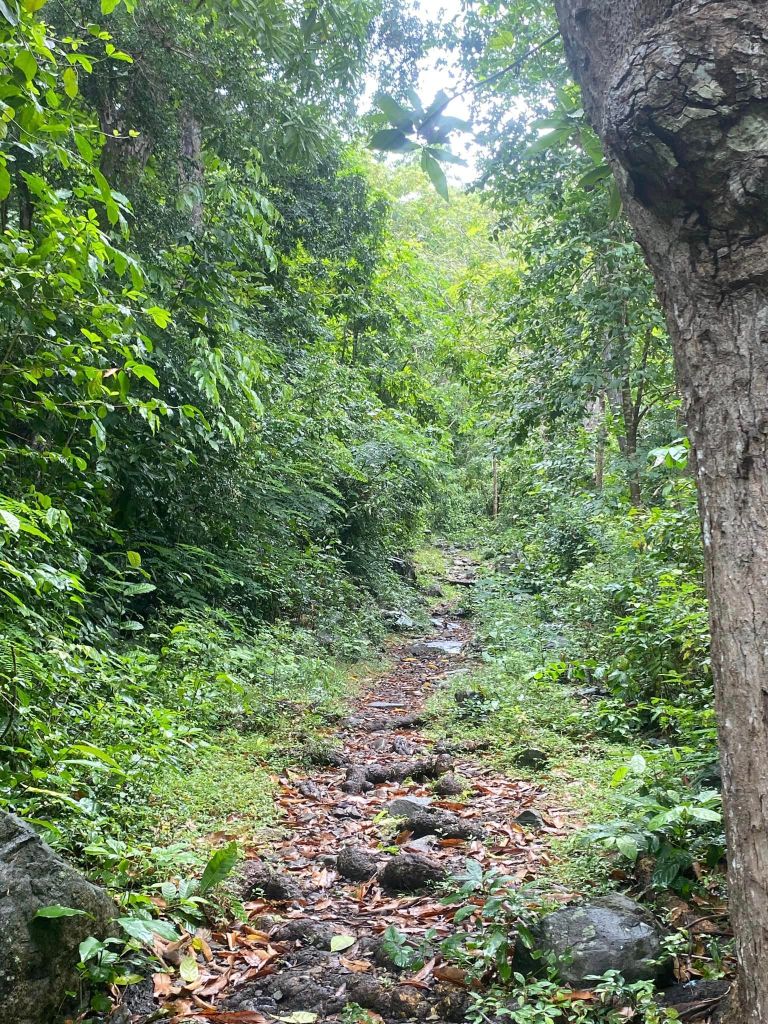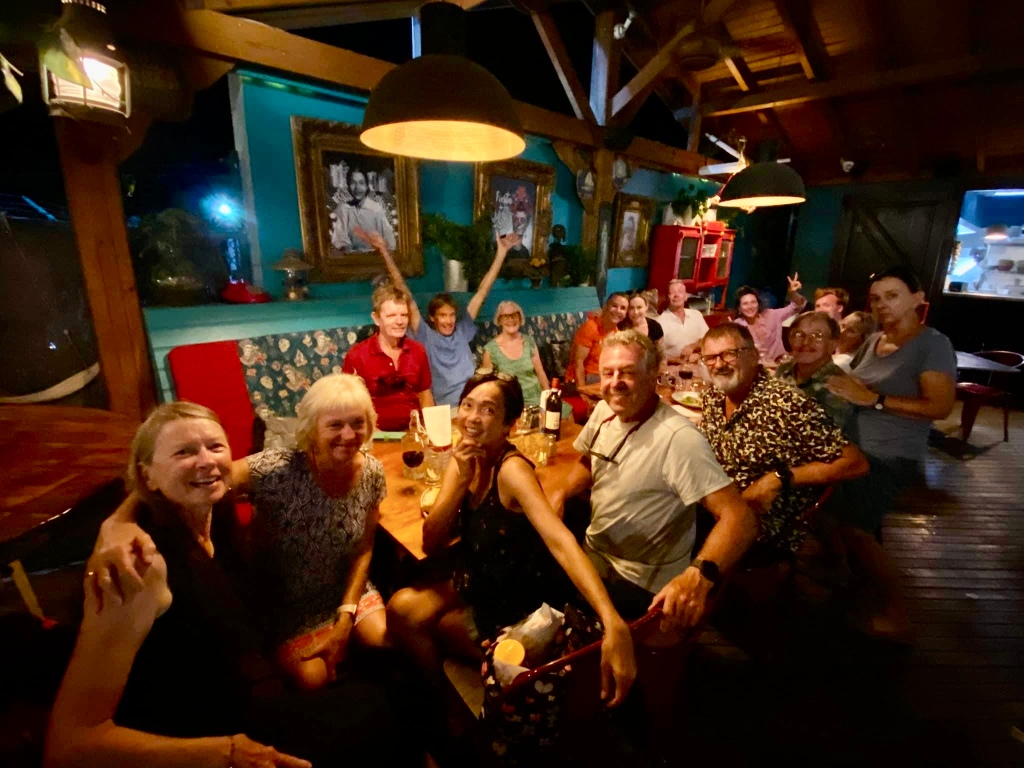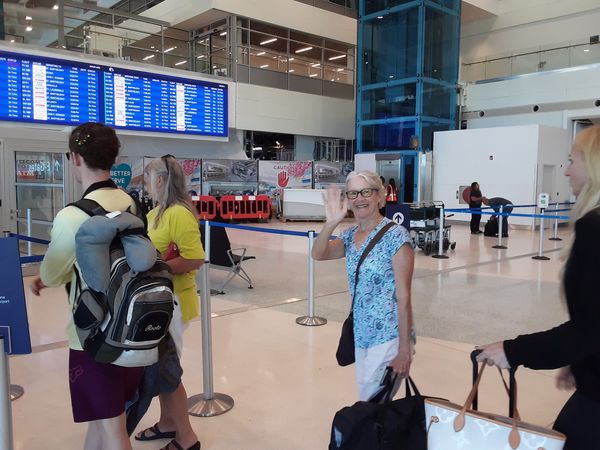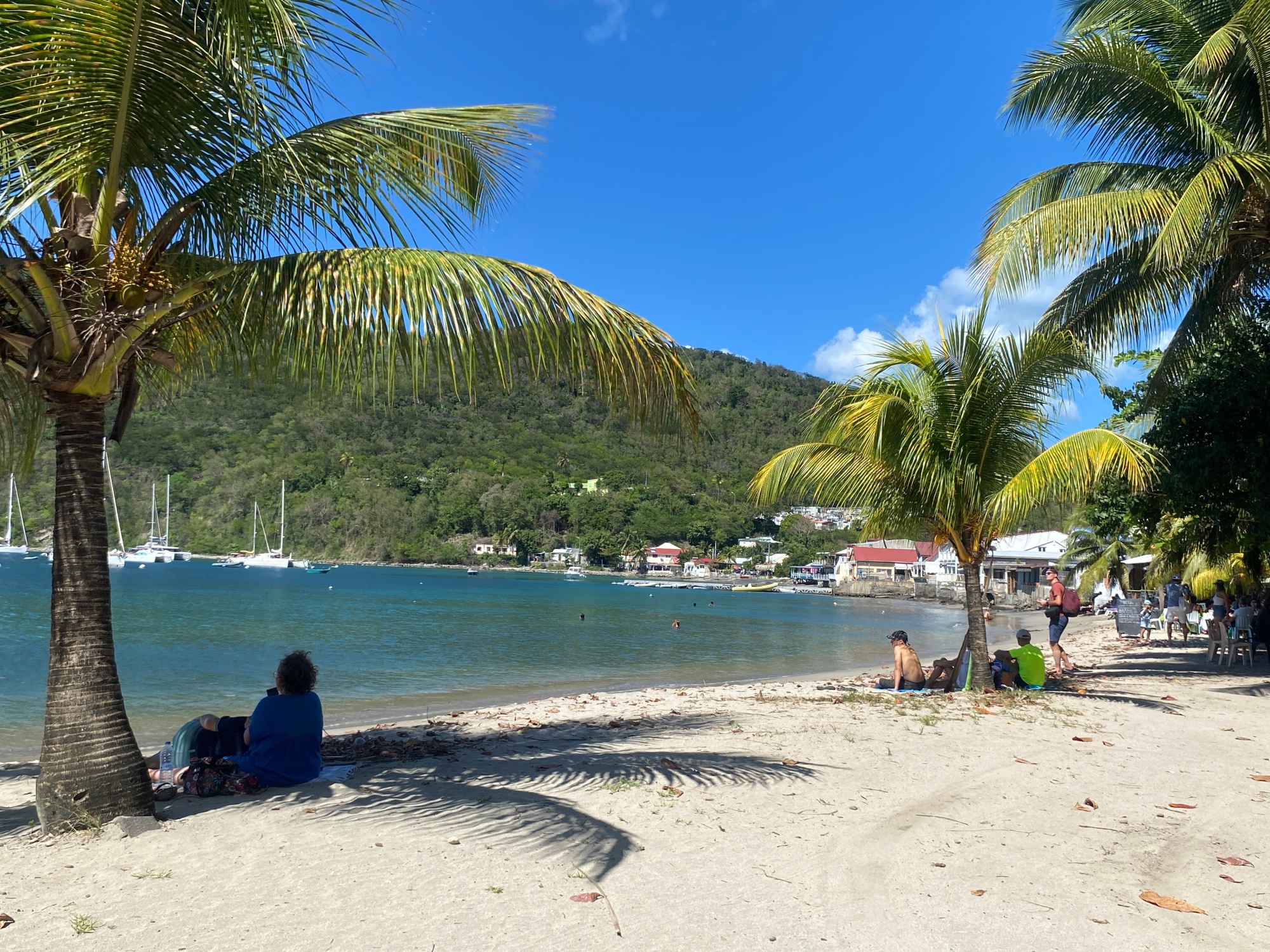February and March 2024
Continuing north from Dominica we visited Guadeloupe, another of the French West Indies, which is actually two islands with a narrow mangrove channel between them, giving it a butterfly shape. We spent all our time on Basse-Terre, the western most “wing”, arriving just in time to see the Mardi Gras parade that is the final formal event in their Carnival celebrations. Carnival in the Caribbean has morphed from the Christian pre-lent festivities brought by the French and Spanish, into a celebration of rebellion against slavery.
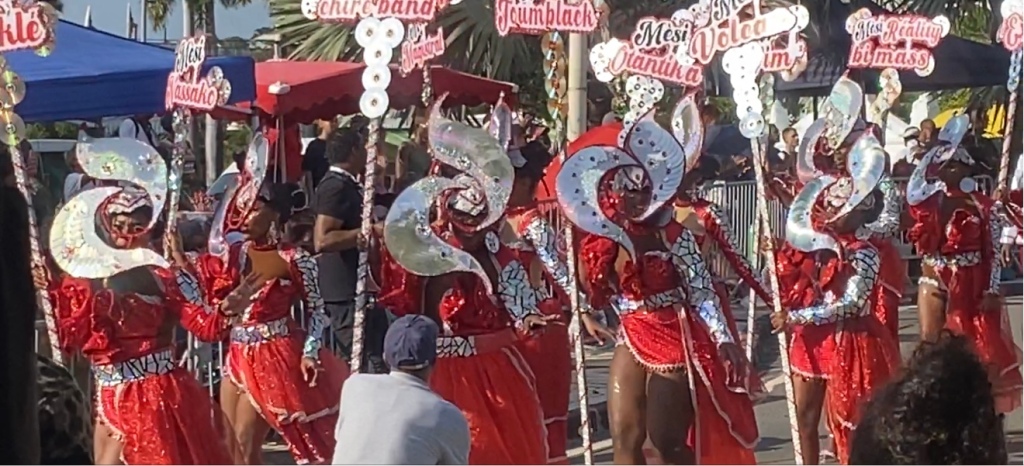
On Dominica we had seen boiling lakes and mud pools, but on Guadualoupe we anchored in Bouillante, a “boiling” bay. Well not quite boiling, but it is fed by a very hot spring. I think the hot spring has always been there, but these days there is a geothermal plant at Bouillante and it also releases hot water into the bay. It makes swimming rather unusual as there are quite warm patches interspersed with cooler water. Our friend Adrian on Anthem had stayed in Guadeloupe to pick up Marianna, who was returning from a stint of family business in Italy. We waited here for them to catch up and it was wonderful to see Marianna again after her few months away.
We left Anthem in Bouillante and pushed on further north to Deshaies, the setting for one of our favourite shows, “Death in Paradise”. We had looked forward with so much anticipation to visiting this town, and we were delighted to find that Brian and Lyn from Ariel were also die-hard fans and would be there at the same time. We had a fabulous time visiting the set of the Honore police station, where you can sit at the desks, “use” the phones, and summarise the case on the white board, just as our favourite characters do in the show. It was a lot of fun.
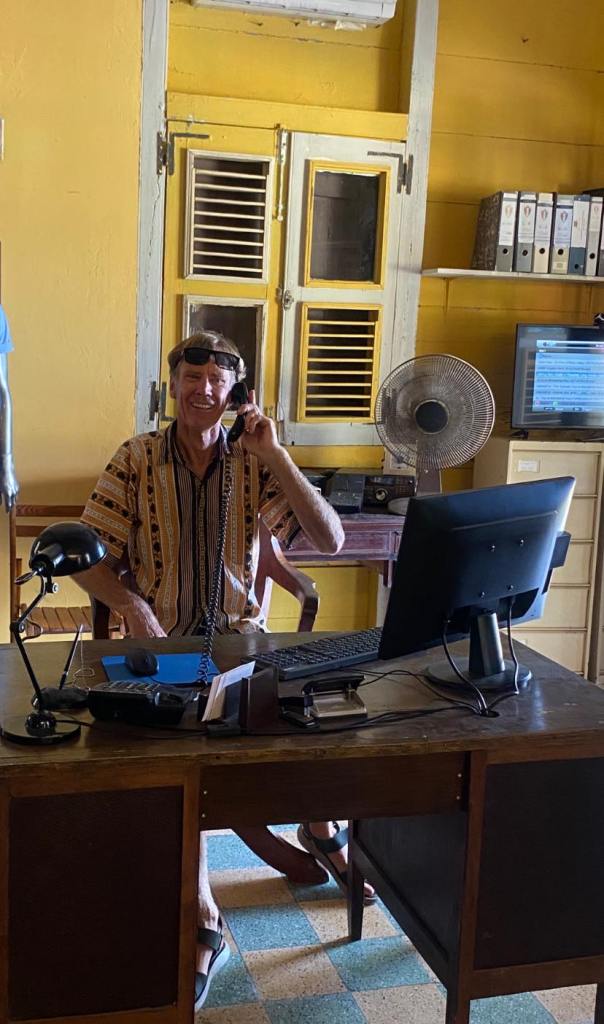
Having solved the crime of the day, we retired to “Catherine’s Bar” (actually called Le Madras) for a sunset drink overlooking the anchorage – again just like in the show.
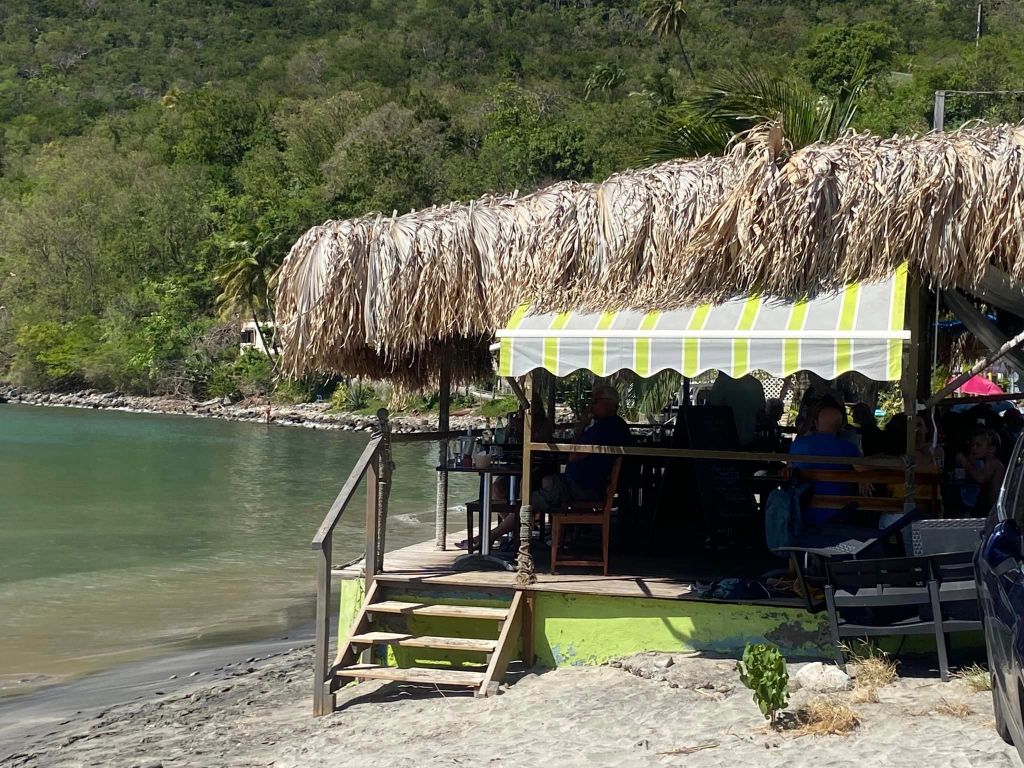
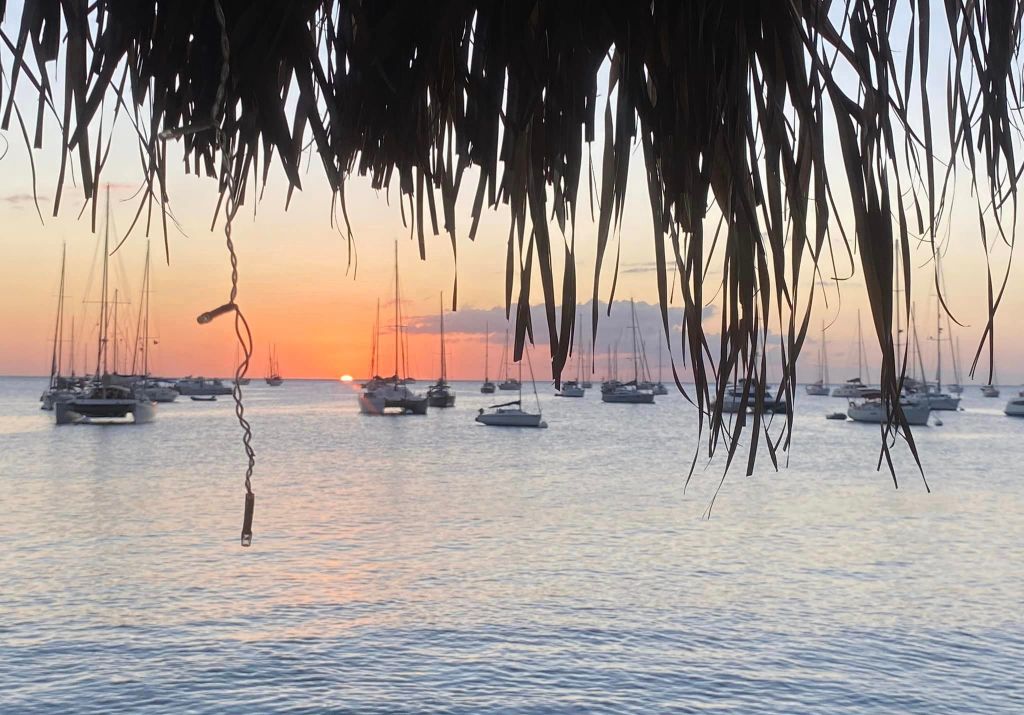
The four of us also walked to Plage de al Perle, the beach that features in the show as the location for the detective’s house. Unfortunately, the house was not there as it is erected each year for filming and then dismantled until the next season.
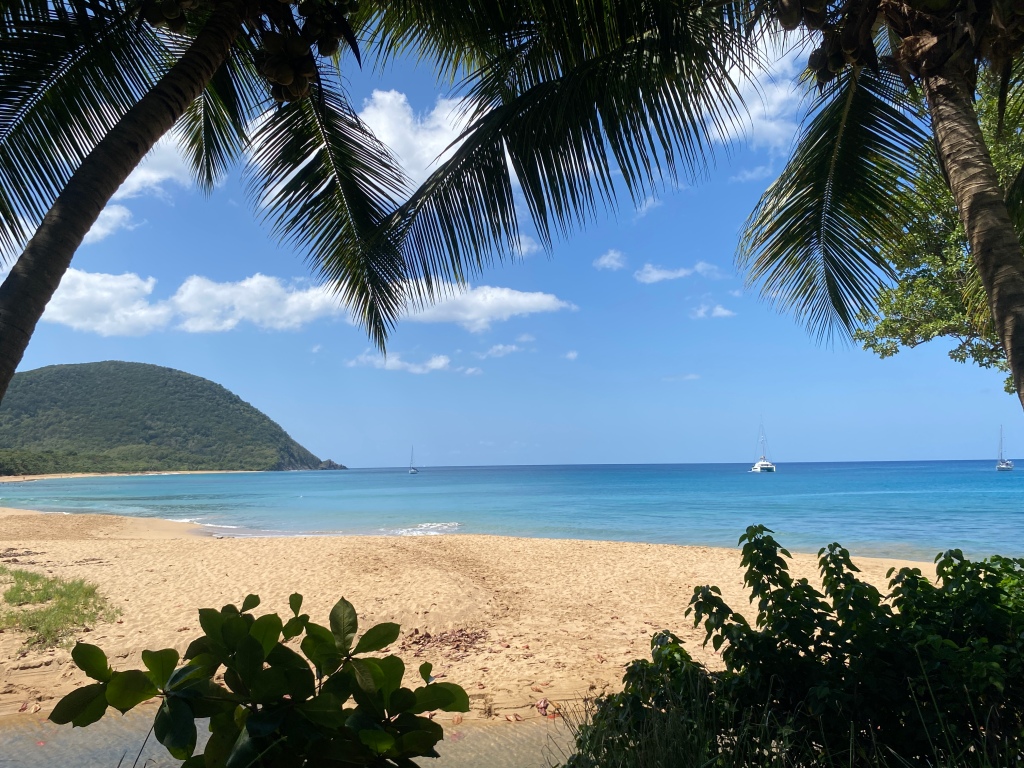
The dense rainforest beauty of the more southern Leeward islands was replaced by beautiful white beaches and more prevalent reefs on the next two islands north: Antigua, and in particular, Barbuda. We spent almost all of our time on Antigua in Falmouth Harbour with the main reason for our visit there being to see English Harbour and Nelson’s Dockyard, and to catch up with friends. We were in two minds about going to Antigua- we knew that English Harbour is one of the great harbours of the world, but we had also heard that Antigua is the home of mega yachts and can be an expensive place to be. One of our friends told us that Antigua is “not what you think” so we decided to give it a go.
There is no doubt that English Harbour is a gorgeous, and well protected, harbour although it’s a compact area and these days is hard to actually anchor there. Certainly the marina seems to be reserved for the mega yachts. We were surprised though that the marina was not lined with luxury boutiques and expensive restaurants. It was a much more modest scene than we had expected. Nelson’s Dockyard, on the shores of English Harbour, is wonderfully restored and has much more charm now than it probably did when it was a working dockyard in a far flung tropical English colony in the 1700 and 1800’s.
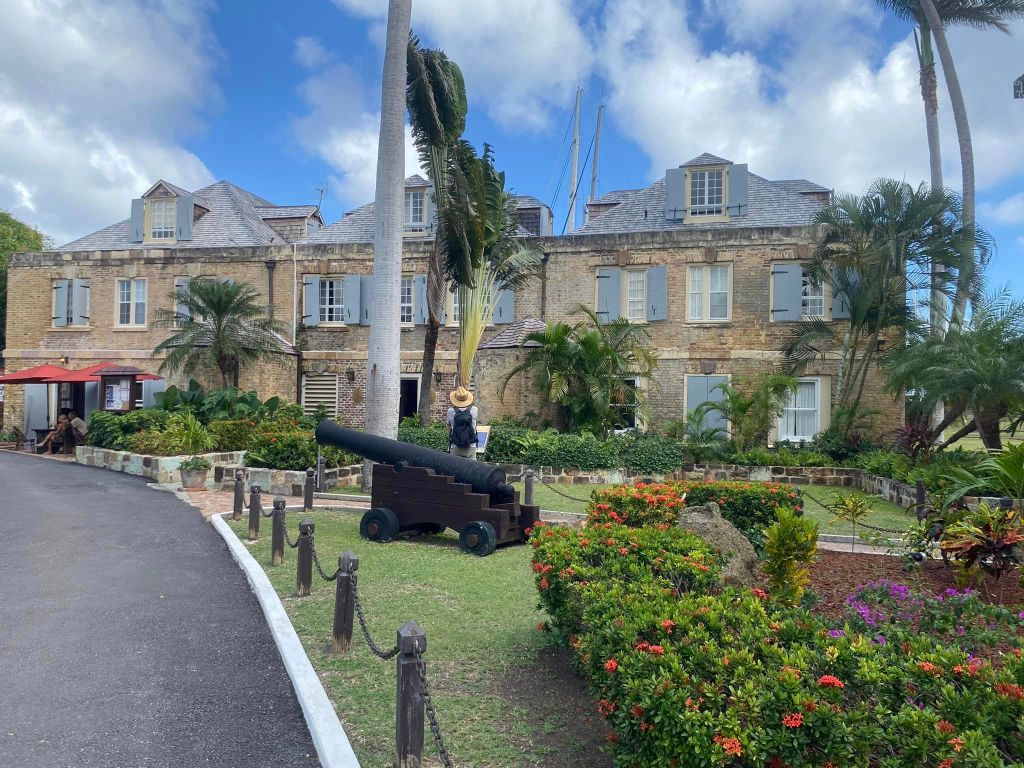
We arrived on Antigua just in time to share a day touring the island with Brian and Lyn, from Ariel. It is nowhere near as beautiful as the more lush southern islands but we had an interesting day learning more about pirates in the Caribbean, and slavery on the plantations, as well as seeing Devils’ Bridge- a work of erosion on the Atlantic coast.
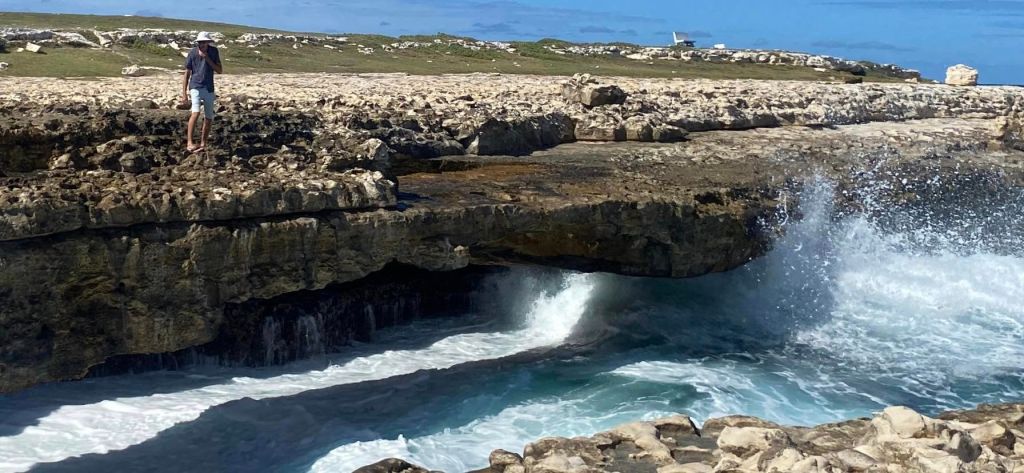
We had heard about the legendary Sunday night BBQ at Shirley Heights on Antigua so we hiked up the hill with Brian and Lyn to check it out. We really needed a beer by the time we got up there and fortunately at that point the queue was not too long. However, when we went to get some dinner, we found a very long queue for the food vouchers and then another queue to actually get the food. We called it quits and had dinner in town instead, but had some time to enjoy the steel pan band before we left.
Brian and Lyn headed off, but we were not alone for long. Dani and Al from Let’s Go, Steve and Liz from Liberte, Hanspeter and Brigit from Shiva, and Adrian and Marianna from Anthem all converged on Falmouth Harbour. It was fabulous to see them all, and we shared sight-seeing, drinks on the beach, and a wonderful day’s walk up to Shirley Heights (again), and back along the coast path.
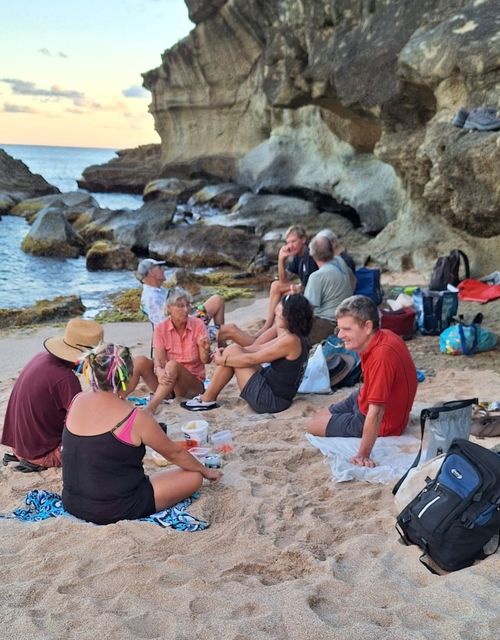


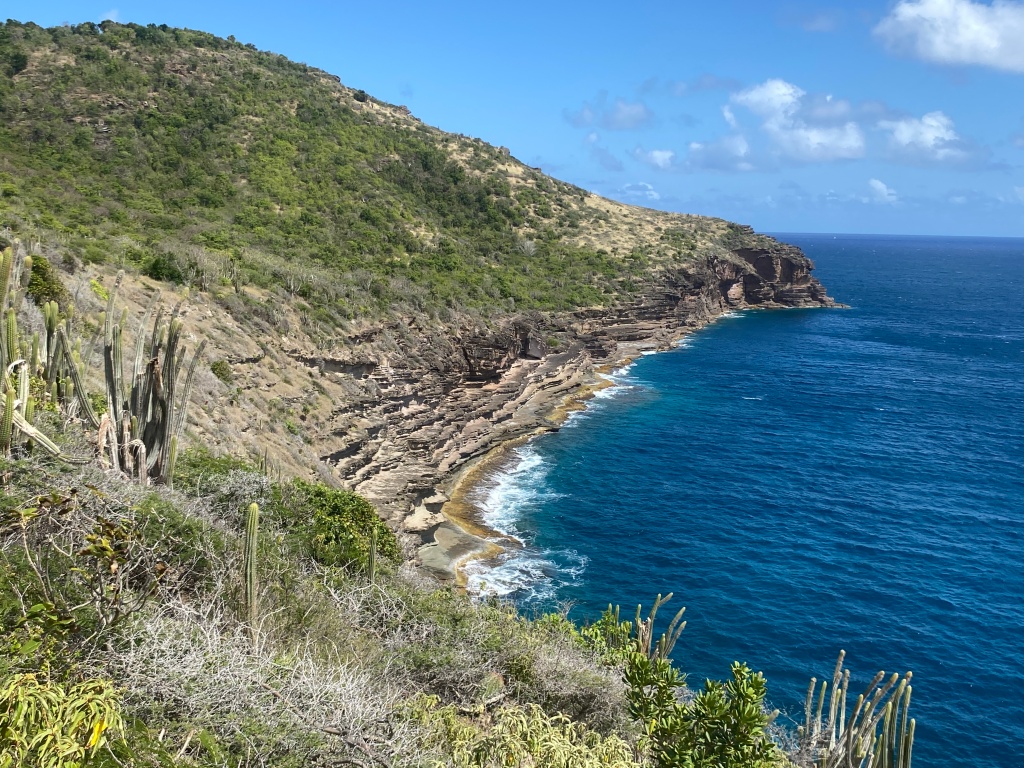
By the time we had caught up with everyone, and the weather was co-operating, we had probably been in Falmouth Harbour for too long. We had forgotten how liberating being out sailing and anchoring in more remote spots can be.
We decided that the forecast was right for a sail north to Barbuda, and for a couple of nights anchoring there. We had heard that it’s one of those places where the anchorages can be very rolly if the conditions are not right. Barbuda is the “forgotten” other half of the nation of Antigua and Barbuda. It is a small island with a population of some 1,600 people, and is one of the most sparsely populated islands in the Caribbean. It was leased for around 200 years by an Englishman, Christopher Codrington, who farmed it to produce food for the enslaved people working on his plantation on Antigua. When slavery was abolished, the small group of freed slaves remained on Barbuda and continued to farm there, owning the land “in common”. The majority of the population on Barbuda can trace their origins back to that small group, so they have a very strong sense of their heritage and ownership of the land.
In more modern times, readers may recall that Barbuda was the island virtually wiped out by Hurricane Irma in 2017 when the whole population were evacuated to Antigua because two further hurricanes were looming. The people gradually returned to pick up their lives and try to re-build but close to all the houses and infrastructure sustained considerable damage. Much of that damage and the resulting debris is still evident today, 7 years after the hurricane. It’s a sad place, and the people there seemed despondent. We spent our first night anchored at Cocoa Point, an idyllic spot in front of a beautiful beach. Ashore for a walk on that incredibly fine white sand we were approached by the Barbuda Beach Club manager and told firmly but politely that the area was private – even the beach. We have struck this elsewhere in our travels but, as we later discovered, battle lines had been drawn between the developers and locals.
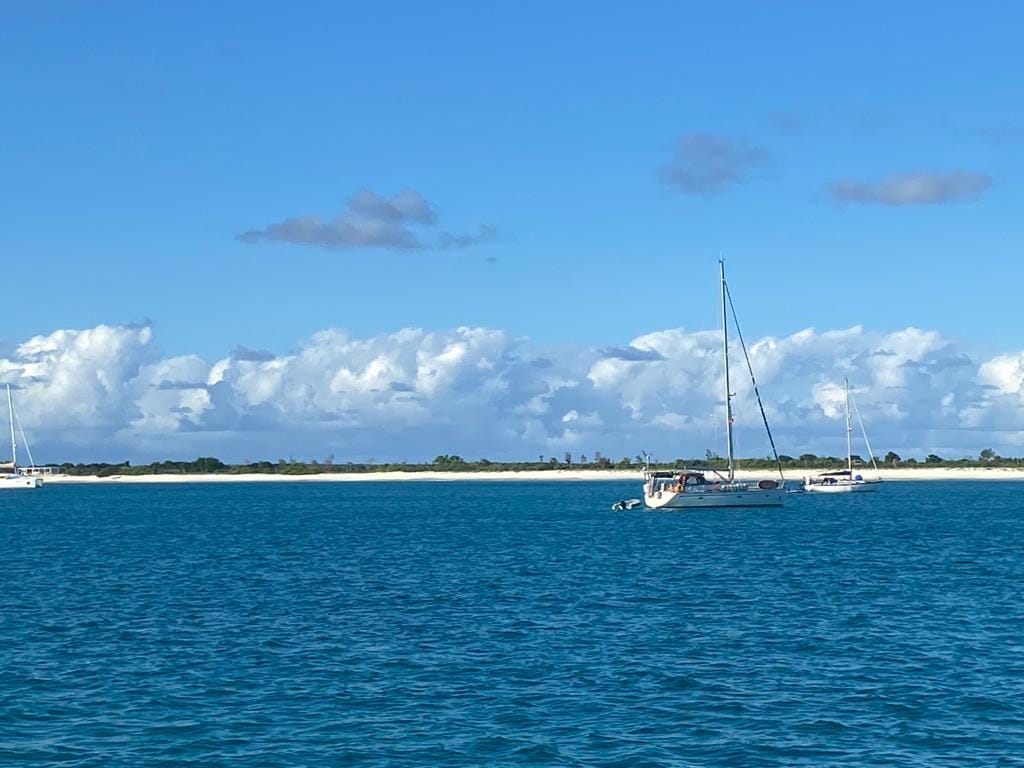
The Antiguan dominated government has seemingly allowed international developers to move in and build an exclusive luxury resort and a private international airstrip, with more resorts, a golf course, and mansions all on the drawing board. Construction on the airstrip actually started during the period when the population were evacuated after the hurricane. The local people we spoke to did not want this development and in their opinion there would be little benefit to them. They are distrustful of the central government and very sceptical that any money from leases etc would flow to benefit Barbuda. There is a dispute regarding the ownership of the land and the legalities are complicated. However, two Barbudans have recently won a Privy Court ruling that they do in fact have the right to challenge the Eastern Caribbean Supreme Court decision that the residents could not take action against the government, particularly relating to the land on which the airstrip has been built. It will be very interesting to follow this David and Goliath story.
Our main reason for going to Barbuda was to visit the frigate bird colony, the second largest such colony in the world. The tour there turned into a bit of a saga. I was unable to contact the recommended tour guide so we decided to just go ashore and see what we could arrange. First, we had to visit the authorities to check out as we were going to leave early the next day and we wanted to be sure we got our affairs in order. It was a bit of a walk over to the airport which is where customs and immigration are located. Job done, we headed back into town to arrange the tour, find out the cost and get some money from an ATM. Barbuda was to be the last island where we would need Eastern Caribbean Dollars and so we were keen to not be left with much of it. We found the departure point for the tours, and made the necessary arrangements but then discovered that the only ATM on the island was over near the airport! Back we went and thank goodness there was actually some money in the machine. So we eventually set off with George the tour guide, and 8 German guys who were on a yacht charter holiday, in George’s open air speed boat.
It was quite a long ride across Codrington Lagoon to the colony. It was lovely to motor slowly through the mangroves and see these large birds roosting in the trees. We saw adult male and female birds, juvenile birds and also a few chicks still with their fluffy white feathers. I wouldn’t say they are a beautiful bird, although they have a large wingspan. It turns out that they also have some dubious hunting techniques. They have little oil in their feathers and so can’t dive into the water to fish, rather they scoop the fish up from just below the surface. But they also bully other smaller birds into dropping their catch and then scoop it up mid-air.
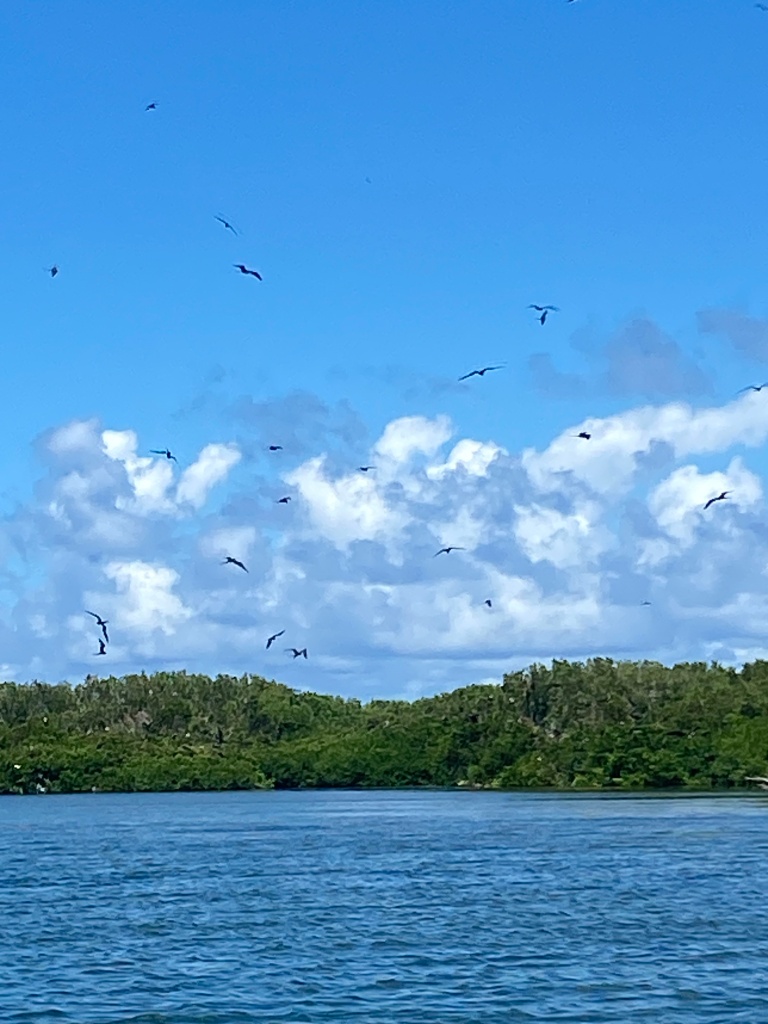
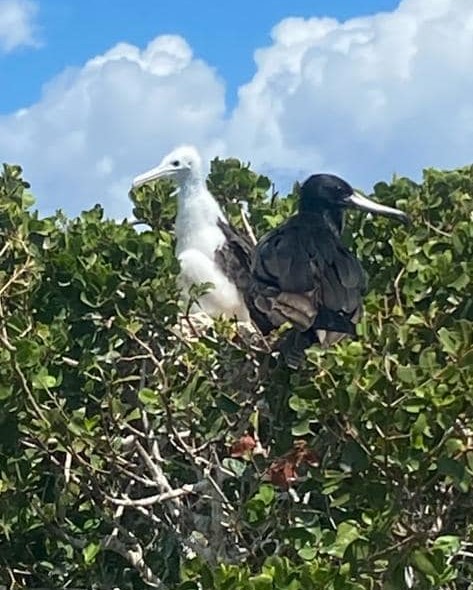
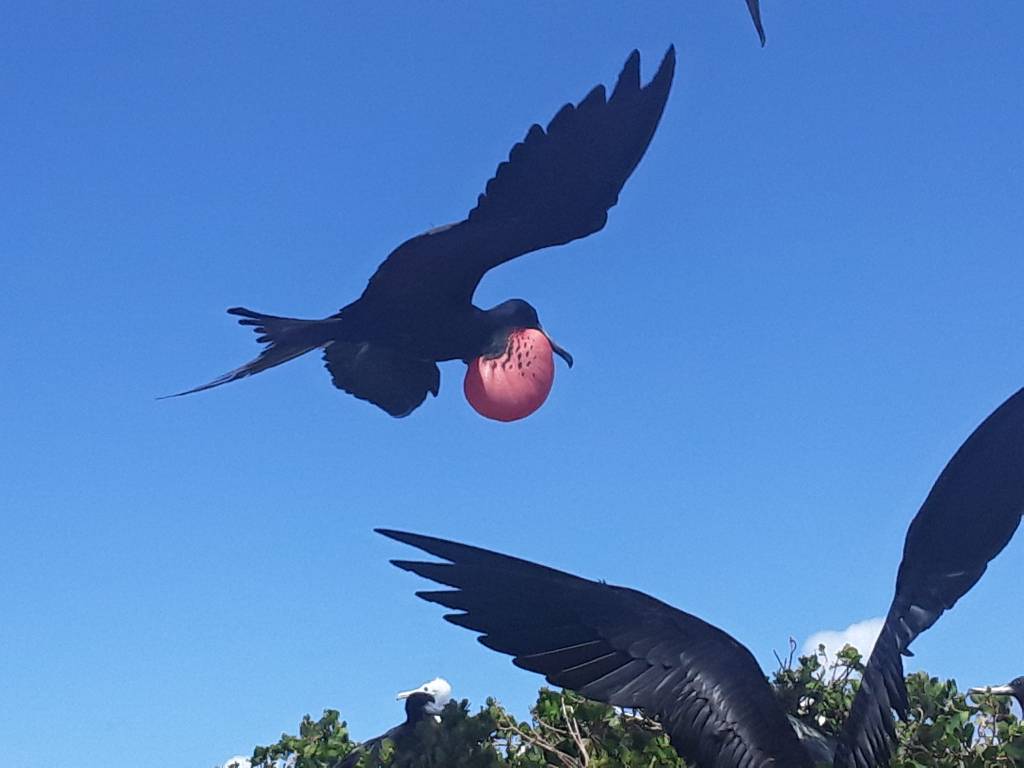
George had had some trouble with the outboard on the way over and had topped up the fuel, thinking that was the problem. But unfortunately for us, it was not the end of the trouble with the outboard stopping altogether after about a quarter of our trip back. So there we were bobbing around at anchor in an open speed boat on a hot day in the middle of a large lagoon. George’s phone had recently died also and he was waiting for a new one to come! We used my phone to call for help, which duly arrived after 30 minutes or so. I used the delay as an opportunity to talk to George about all the development happening on Barbuda and he is most definitely not happy about it, particularly the plans for a villa to be built in the national park that encompasses the lagoon. He told me he is currently in court over the matter, and I later confirmed that in some on-line reporting published recently.
From Barbuda we moved on to Saint Barthelemy (St Barth’s for short) and the contrast could not have been starker. While the two islands share beautiful clear water and white sandy beaches, St Barth’s is very developed and popular with the jet set and luxury sail and motor yachts. Sounds horrible but we were very impressed with the main town and port, Gustavia. The people in the port office were the most welcoming we have come across, and Gustavia itself is very clean and well maintained, has retained some of the old buildings, has good footpaths, a nice public garden, lots of seating around the gorgeous harbour, and an excellent rubbish management system.
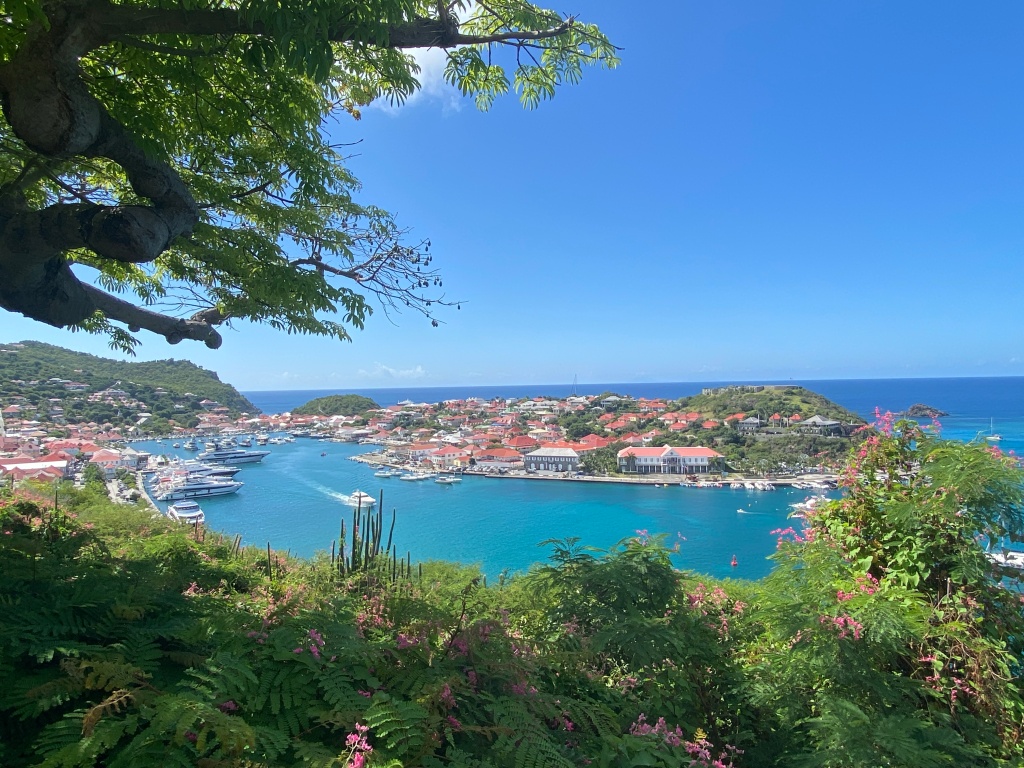
Unlike most of the other Caribbean islands we have visited so far, St Barth’s was never a plantation island, nor did it have a resident population of Arawaks or Caribs, although they did pass through it periodically. The French were the first Europeans here, setting up a base for French pirates. In 1784, the French King gave the island to his mate the Swedish king, Gustaf III, in return for trading rights in Sweden. The Swedes created the port city, naming it after their king. In Swedish fashion, the port was duty free and accessible to ships of all nationalities, and it thrived for a period until fires, storms, epidemics and economic decline ensued. There was never a large enslaved population here, but when slavery was discontinued, there was little work on St Barth’s and so many of the former slaves left for more lucrative work on other islands. It was subsequently returned to France in 1878, and it remained relatively unknown until a well-connected Dutch aviator landed here, and encouraged his wealthy jet set friends, one of whom was Howard Hughes, to visit. So started the reputation of St Barth’s as a place to see and be seen.
Wary of this reputation and the rumoured high costs of visiting there, we initially were not going to visit. But we were encouraged by a yachtie friend to visit Colombier Bay on the west coast and we were so very glad we did. It turned out to be quite economical to take a mooring in this bay, and with no visits to expensive French restaurants or shops, our budget was safe.
From Colombier Bay, we could see the lights of St Martin which meant that my time in the Caribbean was coming to an end. I was soon due to fly out of St Martin to Australia for some surgery on my hip.
St Martin/Sint Maartin is a unique island in that one part of it is French and the other part is Dutch. The land border between the two areas is not controlled so there is free flow from one part to another, and Euros and US dollars are used interchangeably. The Dutch side also has Netherland Antilles Guilders as official currency but I don’t think they are used much. However, the sea border is controlled so if you take the boat from one part to the other, you have to check out and in – and pay the necessary fees which will put a bit of a dent in your wallet on the Dutch side. The island has a lagoon, Simpson Bay Lagoon, which is transected by the border. Entrance to the lagoon is via draw bridges on each side. We anchored in the lagoon on the French side.
With just over two weeks until my flight back to Australia, the priority here for me was family history research. My brother has been diligently working his way through our paternal ancestors and he discovered that our fourth great grand-uncle, Richard Bailey, had acquired a sugar plantation on the French side which was known as La Loterie. The name is a reference to the original owner having won the right to farm the land in a lottery. It’s unclear whether our ancestor was that original owner. Bailey migrated from England to St Martin in the second half of the 18th century and so did some of his sister’s descendants, who went to the Dutch side to farm there and also become very involved in the establishment of the Methodist Church on the island. Interestingly, our second great grand-aunt and her husband ran a plantation on the Dutch side called Diamond Estate which in 1848 became the scene of a dramatic midnight escape of the Estate’s enslaved population to the French side which had recently abolished slavery. Once the enslaved people made it to French soil, they were considered free. Diamond Estate plantation no longer exists but it is the location for an annual re-creation of the escape over the border in celebration of freedom.
The most important order of business was a visit to the Civil Registry to seek registrations of a marriage and some deaths. However, despite many e-mails, phone calls and an in-person visit, I could not even get to first base which was to establish whether in fact they had records for the time period in question, and whether I could physically access them. The Registry does provide a research service and it seemed they were purposely being coy so we would use their service. Undeterred I moved onto the library. I had a list of three books which may have held some clues, but the library building (and many books) had been destroyed in Cyclone Irma in 2017 and the library was at a temporary address with many of the books held in inaccessible off-site storage until a new library was built. Two of the three books were in that off-site storage and I couldn’t find much of relevance in the one available book. The local museum was near the library so we visited there too but while it is quite a good little museum, we didn’t find any new information. I’m not particularly proud that my ancestors profited from slave labour, and felt a little awkward asking people who were highly likely to be descendants of former enslaved people for information about the plantations and their history. When I commented on this, the consistent response of not being able to change the past was given without any trace of animosity.
As our ancestors were active in the Methodist Church, I had the idea that the church might have a record of the marriage and deaths in which we were particularly interested. The church itself was closed but the parish office is just behind it and not only was it open but the secretary was there and she believed that she had marriage records for the relevant time period, but not the deaths. So I put in a formal request for the marriage record and continued on with our quest.
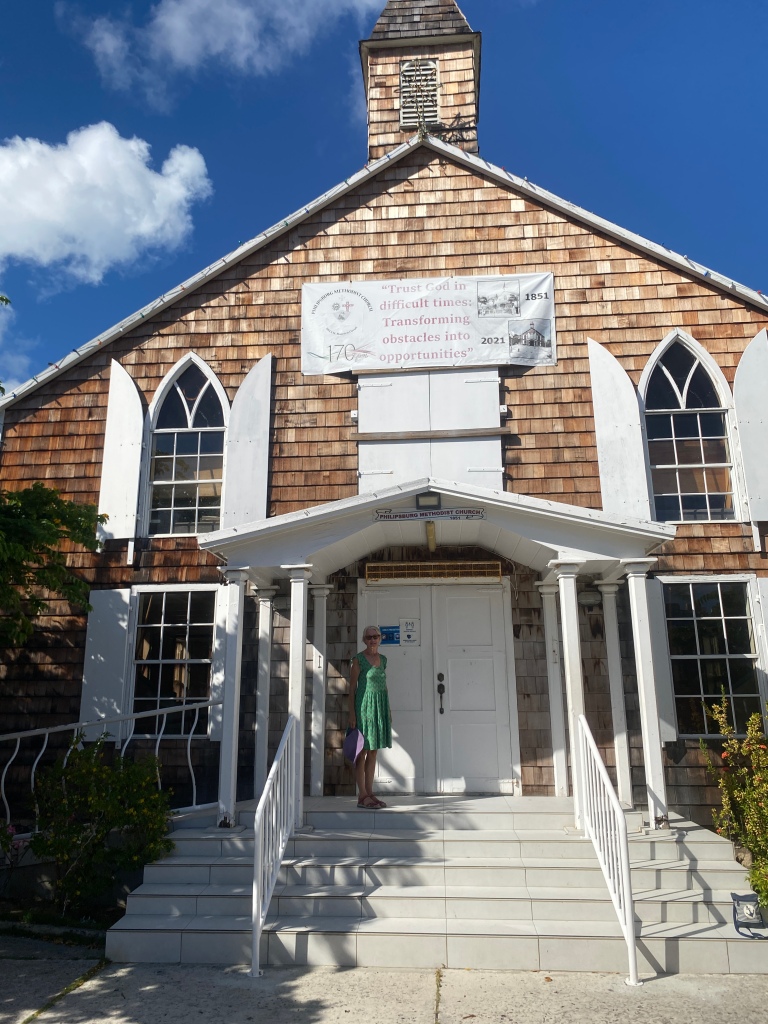
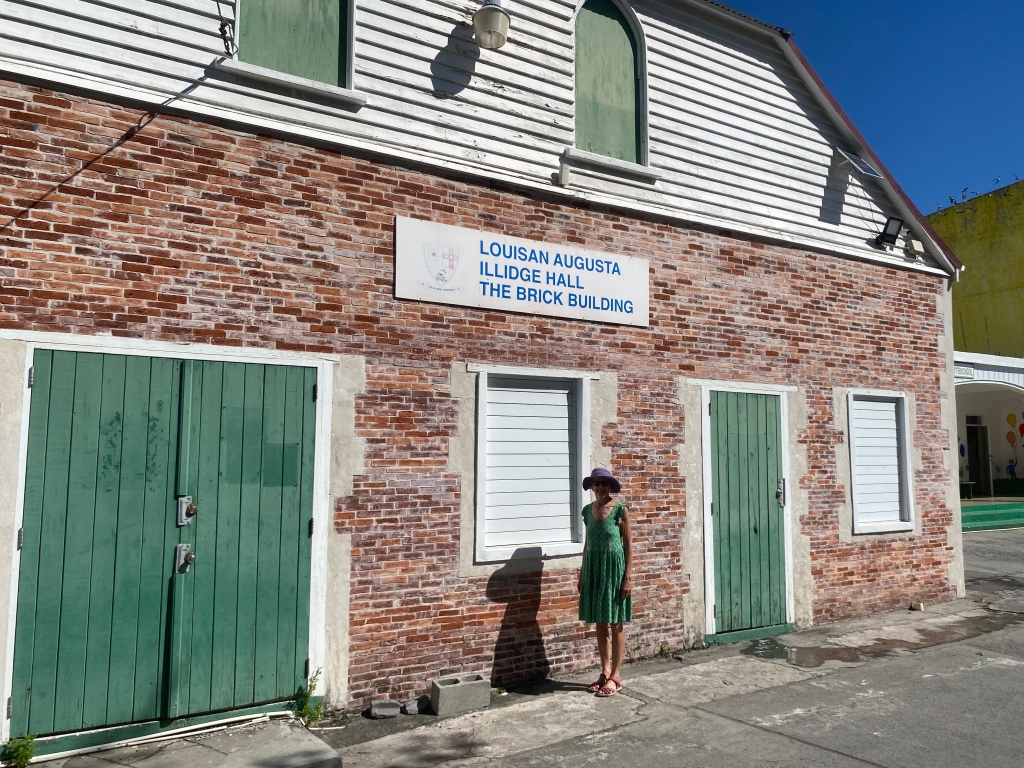
Next stop was the cemetery and here we did indeed find gold – well not real gold, but family history gold. On arrival we found a lovely big tree under which to have our picnic lunch (I know, it’s an unusual spot for a picnic) and then started a methodical search of the graves. Little did we know that right near our picnic spot, buried underneath some very prickly bushes, was a very significant family grave – that of George and Susan Ilidge who were prominent citizens in Sint Marrten and closely involved in the Methodist Church. We were very happy that we had found it.
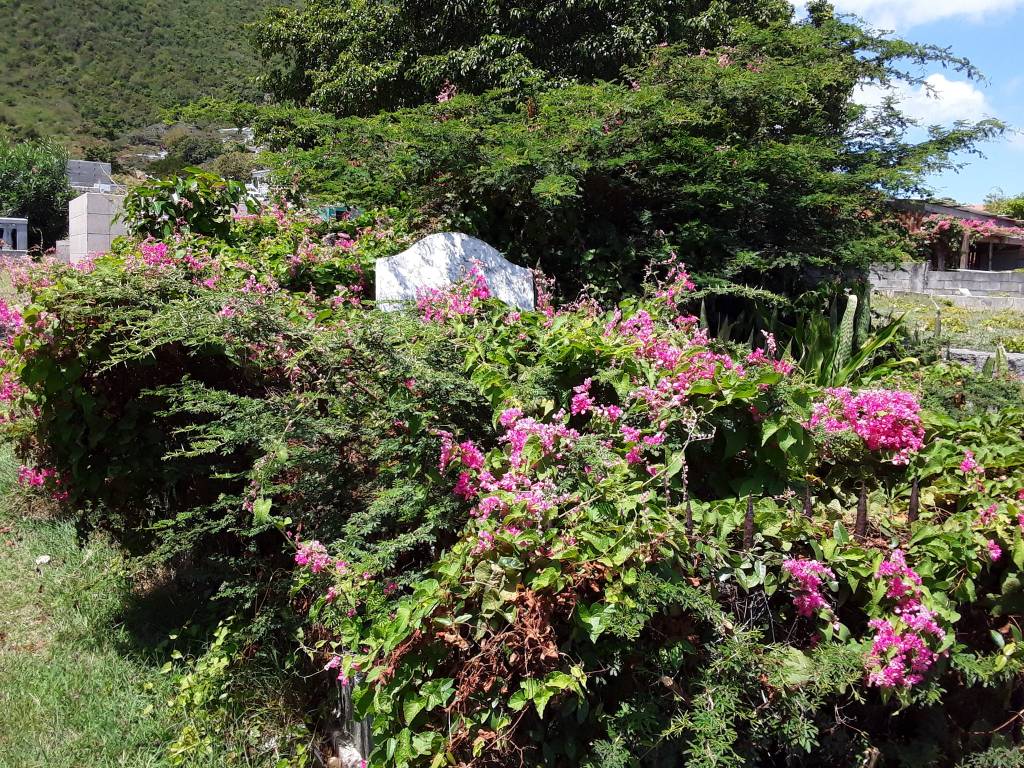
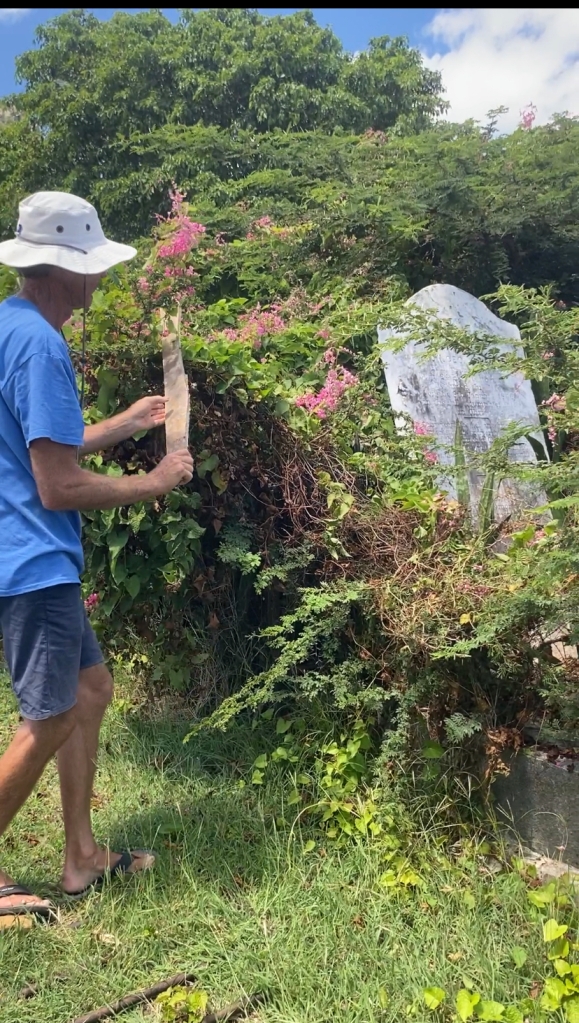
The final piece of my family history mission was to visit La Loterie, located in a lush valley under the highest peak of the island, Pic Paradis. The land is no longer a plantation but eventually came into the hands of an entrepreneur who developed it into a nature reserve with walking trails, zip lines, a swimming pool, and an over-priced restaurant. The web-site indicated that they had some documents relating to the original owner but my attempts to at least have a look at these led to a dead end. So I had to content myself with a visit to the farm and a hike through the valley and up to Pic Paradis. It was a special experience to walk that rather beautiful trail on my own, having sailed to Saint Martin from Australia on our own boat, and to reflect on the lives of my ancestors who had farmed that very land.
